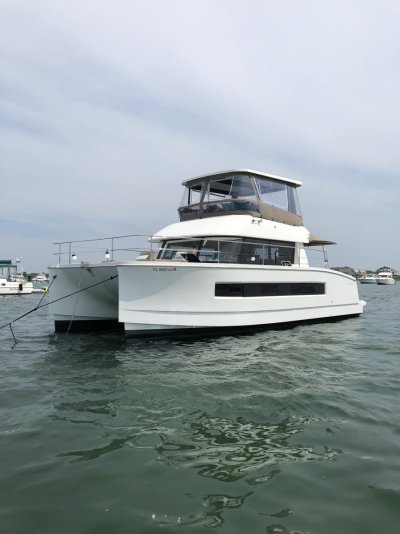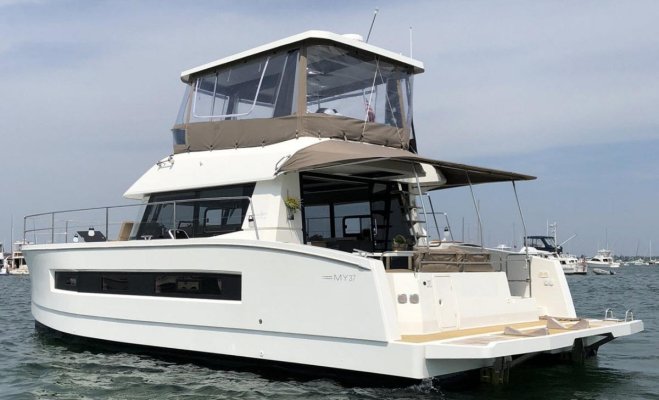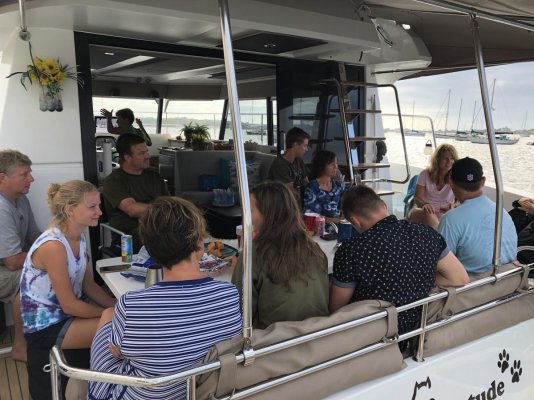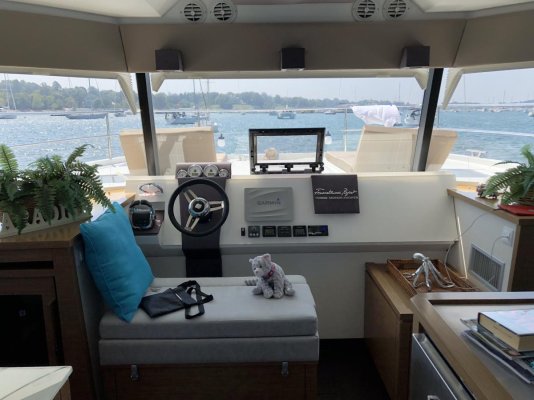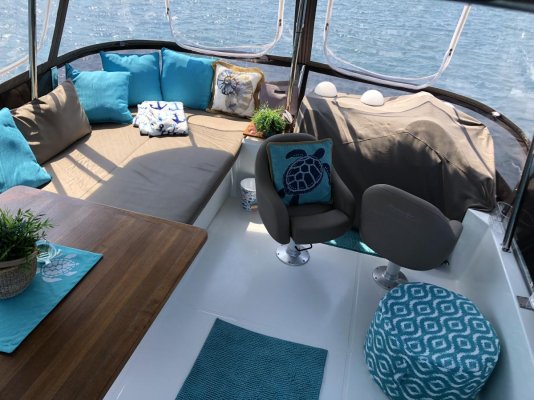I have had many catamaran dreams, although my fantasies are more world wide globe trotter focused than you are planning, even though I would probably never make it out of the Pacific NW with it. The key features I really like about power cats are.
1. Having the living space all on one level, with 360 views. My current boat has an oversized pilot house that doubles as the living room when at anchor, that has really great 360 views. We find that we spend most of our time there when at anchor, even though it would often be more comfortable to be in the back at the dining table, that has great bench seating for lounging around on. The view wins out. I would love a boat that has the dining, area upfront with unobstructed views when you are sitting down, that is well designed for eating, hanging out while underway, lounging around in the evening, and converts to an extra guest bed. The Dashew 64 boats layout is a great example of this, which works well in a cat too. On most trawlers, the space dedicated to the pilot house is the place with the best views, but is not that useful of a space as soon as you hit the dock, or drop the anchor, this seems like a huge waste. My perspective on this is also colored by boating in the Pacific NW where flybridges seem to get little use unless they are fully enclosed, as it it too cold up there most of the year.
2. Cats lend themselves to incredible covered back deck areas that I think would be sweet. I love the idea of a table with built in seating in the shade. I also like the idea of an outdoor, covered place to do smoky/greasy cooking, which we do alot of, and it makes a mess in the galley of our current boat.
3. I would love to have the option to carry 2 dingies. I would like to carry a 12' rowing/sailing dingy on the roof, and a 10' inflatable on the back on davits.
4. Easy to incorporate large amounts of unobstructed solar.
5. Stabilization that is built into the design and works at anchor and underway. My current boat has outriggers and fish, that work great, but are a pain to deploy and retrieve, especially in really bad weather, which is where you need them most. After owning a boat with stabilization, I would not buy another one without it. It makes a huge difference.
6. This would probably only work on larger cats, but I really like the idea of having a modest sized cockpit up in the front, similar to the Chris White sailing cats. This could take the place of a flybridge and offer a much lower wind profile, super convenient access, good shading of the glass, and great unobstructed solar installation. It would not need to be very big, as you have plenty of outdoor space in the back, and since it is so close to the main pilot station, would only need minimal redundant electronics, as you could always just step inside to use the full suite. You could put the windless right there too, and it would be an incredible place to anchor from single handed if set up right.
7. Much easier than typical large trawlers to set up for the type of fishing we do in the Pacific NW. Could be set up for trolling, crab and shrimp pots, etc. If you were designing this in new it would require very little costs and compromise.
8. I like the privacy provided by having rooms in both hulls. I am totally willing to make the compromise of cramped bedrooms, as I spend little time in bedrooms anyways for things other than sleeping. I can put up with the hassle of making the bed in cramped quarters. And it seems like an advantage to have a small space if you wanted to air condition it at night.
9. I really like the option of high speed, while still being able to cruse most of the time at displacement speed with very little compromise as far as I can tell.
Some features I would like to design in, or at least explore more on my dream cat
1. Either vertical, or forward leaning front windows with a nice brow overhang, to keep the sun out, and keep the rain off the windows when at anchor, or moving slowly.
2. Keel coolers, and dry exhaust. I have this on my current boat and love it. It also eliminates a lot of maintenance at the engine itself, which would be good as the access might suck on a cat.
3. Have the keels connect to the rudders with a metal bar to protect the prop, and protect the rudders. There must be a big disadvantage to this that I do not understand, because I have seem almost no cat's that are set up this way, even though it seems cheap and easy to do.
4. Design the boat from the start with modest built in tankage, and large areas that are designed and preplumbed for large custom bladder tanks that can be put in if you want to take a long voyage. This would eliminate the temptation to constantly haul around way more fuel than you need which only weighs you down, and grows scum since you don't use it fast enough. It could be great storage space of you weren't traveling long distances. Would make tank replacement/ inspection super easy. Tankage area could also be swapped between water and fuel if crusing needs warranted.
5. This one is a little crazy, and would need a ton more research, but in theory I like the idea. Build the boat around 2 engines that drive huge hydraulic pumps, then use hydraulic drives for the props, generator, windlass, dingy lift. I know there is an efficiency loss going hydraulic, but it is definitely possible. The cape horn trawlers do it. The advantage would be that you could have completely redundant propulsion as it would be set up with combined circuits between the engines, so both drives could be run off of either engine. Ideally the two engine could be different sizes, and you would run the smaller one for traveling at displacement speeds, or running the generator, and only fire up the big one if you wanted to get up on plane. It would eliminate having a generator engine to buy and maintain. It would allow for optimizing the placement of the engines in the boat for maintenance and weight distribution. It would be truly redundant propulsion that could cross oceans. Hydraulic drive motors are small, and spares could be carried, and installed onboard. The question That I do not know the answer to is at displacement speeds, how does the efficiency gained by running on one engine operating at optimum loading, vs. two larger engine's running at very low loading, compare to the energy lost in the hydraulic system? There are probably a lot of other problems and costs with this idea I do not understand as well.
Another advantage for me, would be that it would allow operation at very low speeds for salmon trolling, which I enjoy, and is a pain on my current boat running on one of the two engines at idle, and it still won't go quite slow enough.

